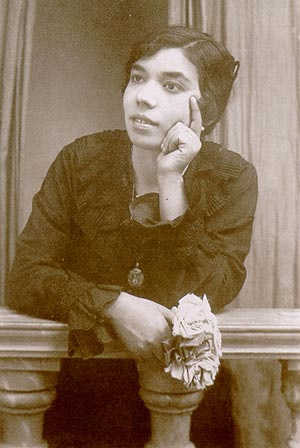La Niña de los Peines

Full name
Place of birth
Biography
Pastora María Pavón Cruz la Niña de los Peines, was born on the 10th of February in 1890 in calle Butrón in the neighbourhood Puerta Osario in Sevilla and died on the 26th of November in 1969 in her home in calle Calatrava, number 20, in Sevilla Many enthusiasts say that she was from Arahal, where her mother and older brother were from; from Tocina, a place where her father was brought up, a blacksmith known as El Paíti who had been born in El Viso del Alcor, and of Alcolea del Río, where it seems that the family lived during some time Her family had flamenco roots and therefore it is no surprise that her older brother, Arturo, was a magisterial singer, perhaps because she had inherited skill from her grandfather on her mothers side for 'tangos´ and those of her father for the 'fragüero´ styleHowever the first time Pastora got on stage was in 1898, when she was hired by a commercial premises in Sevillas´ Festival, in which her brother Arturo also performed, who she had to substitute one day that he got drunk In 1903 the girl from Cadiz debuted in Madrid, in el Café del Brillante, where she became established Ignacio Zuloaga met her there and decided to take her to Bilbao to the Café de las Columnas On returning to Sevilla, after having sat for various paintings depicting customs by the Basque painter, Pastora was known as La Niña de los Peines thanks to some 'tangos´ that only she performed: «Péinate tú con mis peines, que mis peines son de azúcar»-comb me with my combs, they are made from sugar- Later she passed on to the Café de la Marina de Málaga, where she earned three pesetas a day (0,02 euros), thanks to the recommendation of El Pena, father From here she moved on to Jerez earning eight duros (0,24 euros) every night in La Primera At this point Pastora recorded her first album for the record company Zonophone, around 1910 The best theatres in Sevilla hired her to rub shoulders on stage with maestro´s the size of Antonio Chacón The newspapers cited her as the Queen of Flamenco Song The singer wasn´t afraid of facing up to the offers that arrived from the flamenco opera, and in this way toured all of Spain with numerous companies, obtaining great exits in all the bullrings This is when her relationship with the singer Manuel Escacena began, with whom she assures she had a daughter with However the great man of her life was the singer José Torres Garzón el Pinto, also from Sevilla, with whom she married on starting the war Together they took refuge in Madrid Pastora was almost retired from stage during this period On ending the conflict, the singer returned to Sevilla to join Concha Piquers´ company with her husband and along with La Macarrona, La Malena, La Ignacia, María Albaicín, Mari Paz, Pepe el Limpio, Rafael Ortega, Pericón de Cádiz and Melchor de Marchena On ending the tour with Piquer, la Pavón decided to leave the stage but after some years, Pepe Pinto created the show España y su cantaora to return his wife to it The piece was opened in the San Fernando Theatre in Sevilla on the 19th of January 1949 and was a success, but on touring other cities the project fell apart and went directly into bankruptcy The tributes came one after another, a statue was unveiled in Alameda de Hércules in December 1968, when Pastora was very illShe never even found out about the death of her husband, El Pinto, on the 6th of October 1969, who was buried in the San Fernando cemetery in Sevilla in a tomb in which some months later La Niña would also rest With time the Regional Andalusian Government have declared her records as an Asset of Cultural Interest and has created a prize with her name which has been awarded to Fosforito and Paco de Lucía In reference to her creative attitude, Pastora is the mother of the 'bamberas´ style and a type of lengthened 'petenera´ structured from Medinas legacy She left her mark on 'bulerías´, recording the Cielito lindo, 'soleare´, 'seguiriya´ and, above all 'tango´ styles, although it is true that no style as hidden as it may be escapes the personal contributions of an authentic master, monument of flamenco song, whose heritage was recorded in history by means of 355 unequable records





